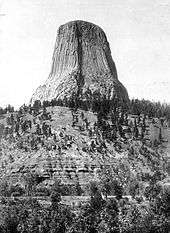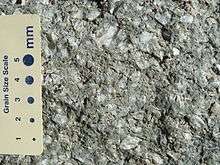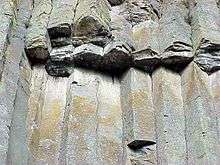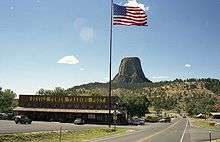Devils Tower
| Devils Tower | |
|---|---|
| Matȟó Thípila (Lakota) | |
 Devils Tower, 2005 | |
| Highest point | |
| Elevation | 5,112 ft (1,558 m) NAVD 88[1] |
| Coordinates | 44°35′25″N 104°42′55″W / 44.59028°N 104.71528°WCoordinates: 44°35′25″N 104°42′55″W / 44.59028°N 104.71528°W [2] |
| Geography | |
| Location | Crook County, Wyoming, US |
| Parent range | Bear Lodge Mountains, part of the Black Hills |
| Topo map | USGS Devils Tower |
| Geology | |
| Mountain type | Laccolith |
| Climbing | |
| First ascent | William Rogers and Willard Ripley, July 4, 1893 |
| Easiest route | Durrance Route |
| Devils Tower National Monument | |
|---|---|
|
IUCN category III (natural monument or feature) | |
 Location in the United States | |
| Nearest city | Hulett, Wyoming |
| Coordinates | 44°35′25″N 104°42′55″W / 44.59028°N 104.71528°W |
| Area | 1,346 acres (545 ha)[3] |
| Established | September 24, 1906 |
| Visitors | 395,203 (in 2011)[4] |
| Governing body | National Park Service |
| Website | Devils Tower National Monument |
Devils Tower (Lakota: Matȟó Thípila or Ptehé Ǧí, which means "Bear Lodge" and "Brown Buffalo Horn", respectively) is a laccolithic butte composed of igneous rock in the Bear Lodge Mountains (part of the Black Hills) near Hulett and Sundance in Crook County, northeastern Wyoming, above the Belle Fourche River. It rises dramatically 1,267 feet (386 m) above the Belle Fourche River, standing 867 feet (265 m) from summit to base. The summit is 5,112 feet (1,559 m) above sea level.
Devils Tower was the first declared United States National Monument, established on September 24, 1906, by President Theodore Roosevelt. The Monument's boundary encloses an area of 1,347 acres (545 ha).
In recent years, about 1% of the Monument's 400,000 annual visitors climbed Devils Tower, mostly using traditional climbing techniques.[5]
Name

Tribes including the Arapaho, Crow, Cheyenne, Kiowa, Lakota, and Shoshone had cultural and geographic ties to the monolith before non-Native Americans reached Wyoming. Their names for the monolith include: Aloft on a Rock (Kiowa), Bear's House (Cheyenne, Crow), Bear's Lair (Cheyenne, Crow), Daxpitcheeaasáao, "Home of bears" (Crow[6]), Bear's Lodge (Cheyenne, Lakota), Bear's Lodge Butte (Lakota), Bear's Tipi (Arapaho, Cheyenne), Tree Rock (Kiowa), and Grizzly Bear Lodge (Lakota).

The name Devil's Tower originated in 1875 during an expedition led by Col. Richard Irving Dodge when his interpreter misinterpreted the name to mean Bad God's Tower, which then became Devil's Tower.[7] All information signs in that area use the name "Devils Tower", following a geographic naming standard whereby the apostrophe is eliminated.[8]
In 2005, a proposal to recognize several American Indian ties through the additional designation of the monolith as Bear Lodge National Historic Landmark met with opposition from United States Representative Barbara Cubin, arguing that a "name change will harm the tourist trade and bring economic hardship to area communities".[9]
In November 2014, Arvol Looking Horse, an American Indian spiritual leader, again proposed renaming the geographical feature "Bear Lodge", and submitted the request to the Board of Geographic Names. A second proposal was submitted to request that the US acknowledge the "offensive" mistake and to rename the monument and sacred site Bear Lodge National Historic Landmark. The formal public comment period ended in fall 2015. Local state senator Ogden Driskill opposed the change.[10][11] The name was not changed.[12]
Geological history

The landscape surrounding Devils Tower is composed mostly of sedimentary rocks. The oldest rocks visible in Devils Tower National Monument were laid down in a shallow sea during the Triassic period, 225 to 195 million years ago. This dark red sandstone and maroon siltstone, interbedded with shale, can be seen along the Belle Fourche River. Oxidation of iron minerals causes the redness of the rocks. This rock layer is known as the Spearfish Formation.
Above the Spearfish formation is a thin band of white gypsum, called the Gypsum Springs Formation. This layer of gypsum was deposited during the Jurassic period, 195 to 136 million years ago.
Created as sea levels and climates repeatedly changed, gray-green shales (deposited in low-oxygen environments such as marshes) were interbedded with fine-grained sandstones, limestones, and sometimes thin beds of red mudstone. This composition, called the Stockade Beaver member, is part of the Sundance Formation. The Hulett Sandstone member, also part of the Sundance formation, is composed of yellow fine-grained sandstone. Resistant to weathering, it forms the nearly vertical cliffs which encircle the Tower itself.
During the Paleocene Epoch, 56 to 66 million years ago, the Rocky Mountains and the Black Hills were uplifted. Magma rose through the crust, intruding into the existing sedimentary rock layers.[13]
Theories of formation


Geologists Carpenter and Russell studied Devils Tower in the late 19th century and came to the conclusion that it was formed by an igneous intrusion. Modern geologists agree that it was formed by the intrusion of igneous material, but not on exactly how that process took place. Several believe the molten rock comprising the Tower might not have surfaced; others are convinced the tower is all that remains of what once was a large explosive volcano.
In 1907, scientists Darton and O'Harra decided that Devils Tower must be an eroded remnant of a laccolith. A laccolith is a large mass of igneous rock which is intruded through sedimentary rock beds without reaching the surface, but makes a rounded bulge in the sedimentary layers above. This theory was quite popular in the early 20th century since numerous studies had earlier been done on laccoliths in the Southwest.
Other theories have suggested that Devils Tower is a volcanic plug or that it is the neck of an extinct volcano. Presumably, if Devils Tower was a volcanic plug, any volcanics created by it — volcanic ash, lava flows, volcanic debris — would have been eroded away long ago. Some pyroclastic material of the same age as Devils Tower has been identified elsewhere in Wyoming.
The igneous material that forms the Tower is a phonolite porphyry intruded about 40.5 million years ago,[14] a light to dark-gray or greenish-gray igneous rock with conspicuous crystals of white feldspar.[15] As the magma cooled, hexagonal (and sometimes 4-, 5-, and 7-sided) columns formed. As the rock continued to cool, the vertical columns shrank in cross-section (horizontally) and cracks began to occur at 120 degree angles, generally forming compact 6-sided columns. The nearby Missouri Buttes, 3.5 miles (5.6 km) to the northwest of Devils Tower, are also composed of columnar phonolite of the same age. (Devils Postpile National Monument in California and Giant's Causeway in Northern Ireland, are also columnar basalt, which are superficially similar, but with columns typically 2 feet (0.61 m) diameter.)
Devils Tower did not visibly protrude out of the landscape until the overlying sedimentary rocks eroded away. As the elements wore down the softer sandstones and shales, the more resistant igneous rock making up the tower survived the erosional forces. As a result, the gray columns of Devils Tower began to appear as an isolated mass above the landscape.
As rain and snow continue to erode the sedimentary rocks surrounding the Tower's base, more of Devils Tower will be exposed. Nonetheless, the exposed portions of the Tower still experience certain amounts of erosion. Cracks along the columns are subject to water and ice erosion. Erosion due to the expansion of ice along cracks and fractures within rock formations is common in colder climates — a prime example being the featured formations at Bryce Canyon National Park. Portions, or even entire columns, of rock at Devils Tower are continually breaking off and falling. Piles of broken columns, boulders, small rocks, and stones — or scree — lie at the base of the tower, indicating that it was once wider than it is today.[13]
Native American folklore

According to the Native American tribes of the Kiowa and Lakota, a group of girls went out to play and were spotted by several giant bears, who began to chase them. In an effort to escape the bears, the girls climbed atop a rock, fell to their knees, and prayed to the Great Spirit to save them. Hearing their prayers, the Great Spirit made the rock rise from the ground towards the heavens so that the bears could not reach the girls. The bears, in an effort to climb the rock, left deep claw marks in the sides, which had become too steep to climb. (Those are the marks which appear today on the sides of Devils Tower.) When the girls reached the sky, they were turned into the stars of the Pleiades.
Another version tells that two Sioux boys wandered far from their village when Mato the bear, a huge creature that had claws the size of tipi poles, spotted them, and wanted to eat them for breakfast. He was almost upon them when the boys prayed to Wakan Tanka the Creator to help them. They rose up on a huge rock, while Mato tried to get up from every side, leaving huge scratch marks as he did. Finally, he sauntered off, disappointed and discouraged. The bear came to rest east of the Black Hills at what is now Bear Butte. Wanblee, the eagle, helped the boys off the rock and back to their village. A painting depicting this legend by artist Herbert A. Collins hangs over the fireplace in the visitor's center at Devils Tower.
In a Cheyenne version of the story, the giant bear pursues the girls and kills most of them. Two sisters escape back to their home with the bear still tracking them. They tell two boys that the bear can only be killed with an arrow shot through the underside of its foot. The boys have the sisters lead the bear to Devils Tower and trick it into thinking they have climbed the rock. The boys attempt to shoot the bear through the foot while it repeatedly attempts to climb up and slides back down leaving more claw marks each time. The bear was finally scared off when an arrow came very close to its left foot. This last arrow continued to go up and never came down.[16]
Wooden Leg, a Northern Cheyenne, relates another legend told to him by an old man as they were traveling together past the Devils Tower around 1866–1868. An Indian man decided to sleep at the base of Bear Lodge next to a buffalo head. In the morning he found that both he and the buffalo head had been transported to the top of the rock by the Great Medicine with no way down. He spent another day and night on the rock with no food or water. After he had prayed all day and then gone to sleep, he awoke to find that the Great Medicine had brought him back down to the ground, but left the buffalo head at the top near the edge. Wooden Leg maintains that the buffalo head was clearly visible through the old man's spyglass. At the time, the tower had never been climbed and a buffalo head at the top was otherwise inexplicable.[17]
The buffalo head gives this story special significance for the Northern Cheyenne. All the Cheyenne maintained in their camps a sacred teepee to the Great Medicine containing the tribal sacred objects. In the case of the Northern Cheyenne, the sacred object was a buffalo head.[18]
Recent history
Fur trappers may have visited Devils Tower, but they left no written evidence of having done so. The first documented Caucasian visitors were several members of Captain William F. Raynolds' 1859 expedition to Yellowstone. Sixteen years later, Colonel Richard I. Dodge escorted an Office of Indian Affairs scientific survey party to the massive rock formation and coined the name Devils Tower.[19] Recognizing its unique characteristics, Congress designated the area a U.S. forest reserve in 1892 and in 1906 Devils Tower became the nation's first National Monument.[20]
The 1977 movie Close Encounters of the Third Kind used the formation as a plot element and as the location of its climactic scenes.[21][22] Its release was the cause of a large increase in visitors and climbers to the monument.[23]
Climbing

In recent years, climbing Devils Tower National Monument has increased in popularity. The first known ascent of Devils Tower by any method occurred on July 4, 1893, and is accredited to William Rogers and Willard Ripley, local ranchers in the area. They completed this first ascent after constructing a ladder of wooden pegs driven into cracks in the rock face. A few of these wooden pegs are still intact and are visible on the tower when hiking along the 1.3-mile (2.1 km) Tower Trail at Devils Tower National Monument. Over the following thirty years many climbs were made using this method before the ladder fell into disrepair. The man most famous for climbing the tower is Fritz Wiessner, who summited with William P. House and Lawrence Coveney in 1937. This was the first ascent using modern climbing techniques. Wiessner led the entire climb free, placing only a single piece of fixed gear, a piton, which he later regretted, deeming it unnecessary.
In 1941 George Hopkins parachuted onto Devils Tower, without permission, as a publicity stunt resulting from a bet. He had intended to descend by a rope dropped with him, but this failed to land on the tower summit. Hopkins was stranded for six days, exposed to cold, rain and 50 mph winds before a mountain rescue team finally reached him and brought him down.[24][25] His entrapment and subsequent rescue was widely covered by the media of the time.[26]
Today, hundreds of climbers scale the sheer rock walls of Devils Tower each summer. The most common route is the Durrance Route, which was the second free route established in 1938. There are many established and documented climbing routes covering every side of the tower, ascending the various vertical cracks and columns of the rock. The difficulty of these routes range from relatively easy to some of the hardest in the world. All climbers are required to register with a park ranger before and after attempting a climb. No overnight camping at the summit is allowed; climbers return to base on the same day they ascend.[27]
The Tower is sacred to several Plains tribes, including the Lakota, Cheyenne and Kiowa. Because of this, many Indian leaders objected to climbers ascending the monument, considering this to be a desecration. The climbers argued that they had a right to climb the Tower, since it is on federal land. A compromise was eventually reached with a voluntary climbing ban during the month of June when the tribes are conducting ceremonies around the monument. Climbers are asked, but not required, to stay off the Tower in June. According to the PBS documentary In the Light of Reverence, approximately 85% of climbers honor the ban and voluntarily choose not to climb the Tower during the month of June. However, several climbers along with the Mountain States Legal Foundation sued the Park Service, claiming an inappropriate government entanglement with religion.[28]
See also
Four areas of Devils Tower National Monument on the National Register of Historic Places:
- Entrance Road (Devils Tower National Monument)
- Entrance Station (Devils Tower National Monument)
- Old Headquarters Area Historic District
- Tower Ladder (Devils Tower National Monument)
References
- ↑ "Devils Tower, Wyoming". Peakbagger.com. Retrieved December 14, 2012.
- ↑ "Devils Tower". Geographic Names Information System. United States Geological Survey. Retrieved December 14, 2012.
- ↑ "Listing of acreage as of December 31, 2011". Land Resource Division, National Park Service. Retrieved May 13, 2012.
- ↑ "NPS Annual Recreation Visits Report". National Park Service. Retrieved June 30, 2011.
- ↑ Devils Tower NM – Final Climbing Management Plan National Park Service, page 4, February 1995, accessed March 13, 2009
- ↑ "Little Big Horn College Library". Retrieved June 5, 2012.
- ↑ NPS Frequently Asked Questions, accessed July 22, 2008
- ↑ "USGS Frequently Asked Questions, #18". United States Geological Survey. Retrieved November 29, 2012.
- ↑ "Cubin Fights Devils Tower Name Change". Archived from the original on December 26, 2008. Retrieved July 22, 2008.
- ↑ "Request made to change Devils Tower name to Bear Lodge". Rapid City Journal. Associated Press. June 22, 2015. Retrieved July 19, 2015.
- ↑ Hancock, Laura (June 20, 2015). "Proposal could rename Devils Tower to Bear Lodge (with PDFs)". Casper Star-Tribune. Casper, WY. Retrieved September 24, 2015. PDFs include "Bear Lodge name change proposal" and "National Park Service information on name change"
- ↑ see http://geonames.usgs.gov/index.html
- 1 2 National Park Service: Devils Tower: Geologic Formations
- ↑ Bassett, W. A. (October 1961). "Potassium-Argon Age of Devils Tower, Wyoming". Science. 134 (3487): 1373–1373. Bibcode:1961Sci...134.1373B. doi:10.1126/science.134.3487.1373. ISSN 0036-8075.
- ↑ Woolley, A. R. (1987) Alkaline Rocks and Carbonatites of the World, Part 1: North and South America, London, British Museum (Natural History), page 126
- ↑ Marquis, pp. 53–54
- ↑ Marquis, pp. 54–55
- ↑ Marquis p. 106 and p. 152
- ↑ Dodge, Richard (1996). Wayne R. Kime, ed. The Black Hills journals of Colonel Richard Irving Dodge. University of Oklahoma Press. p. 6. ISBN 0-8061-2846-1.
- ↑ "Listing of National Park System Areas by State". National Park Service. Archived from the original on June 29, 2011. Retrieved June 30, 2011.
- ↑ "Close Encounters of the Third Kind (1977)". Filmsite. Retrieved November 3, 2011.
- ↑ Warren Buckland, Directed by Steven Spielberg: Poetics of The Contemporary Hollywood Blockbuster, pages 111–129 (New York: The Continuum International Publishing Group Inc, 2006). ISBN 978-0-8264-1691-9
- ↑ Allen Carlson, Nature and Landscape: An Introduction to Environmental Aesthetics, p.122, Columbia University Press, 2009 ISBN 023114041X.
- ↑ John Darwin Dorst, Looking West, p.202, University of Pennsylvania Press, 1999 ISBN 0812214404.
- ↑ "Parachutist gains five pounds while stranded on rock", The Victoria Advocate, October 7, 1941.
- ↑ See for instance, "Alpinists bring down man on Devil's Tower; 'rather go back than face crowd,' he says", New York Times, p. 25, October 7, 1941.(subscription required)
- ↑ devilstowerclimbing.com
- ↑ Sacred Land Film Project, Devils Tower.
Bibliography
- Marquis, Thomas B. (2003). Wooden Leg: A Warrior Who Fought Custer. Lincoln, Neb.: University of Nebraska Press, Bison Books. ISBN 0-8032-8288-5. OCLC 52423964, OCLC 57065339. Wooden Leg: A Warrior Who Fought Custer at Google Books.
External links
| Wikimedia Commons has media related to Devils Tower National Monument. |
| Wikivoyage has a travel guide for Devils Tower. |
- Devils Tower National Monument - National Park Service
- The short film Tower of Stone is available for free download at the Internet Archive - public domain, produced by National Park Service.
- 450 megapixel high-resolution photo of Devils Tower